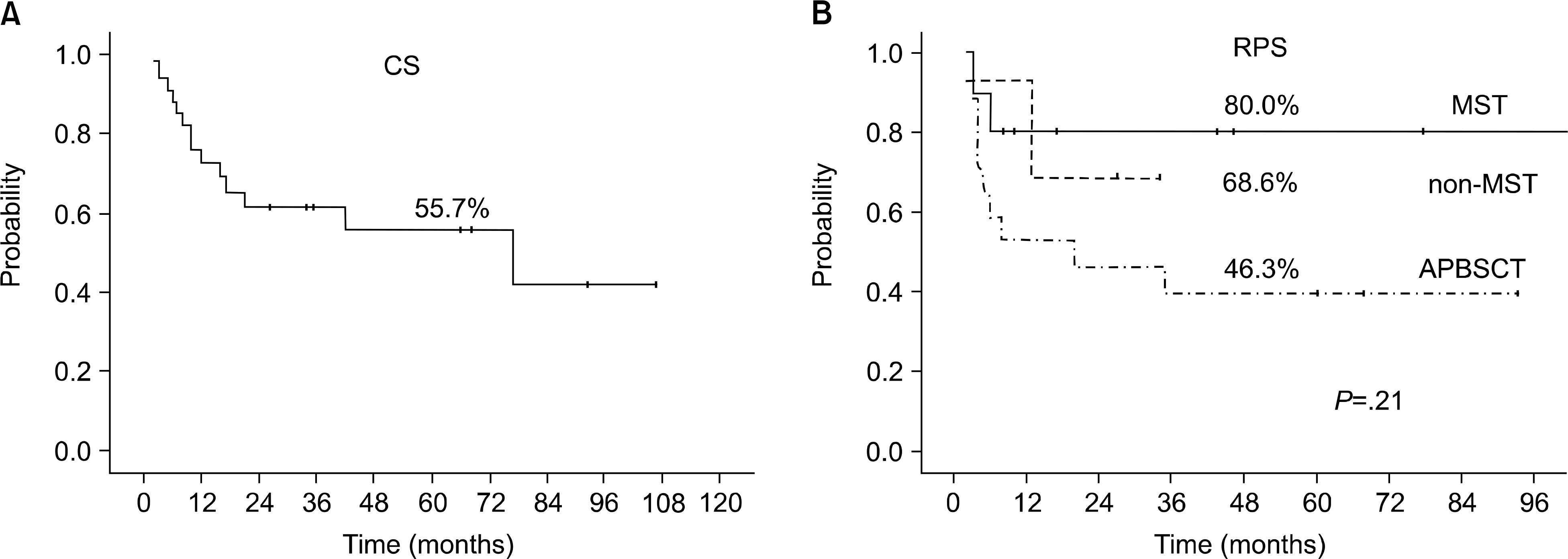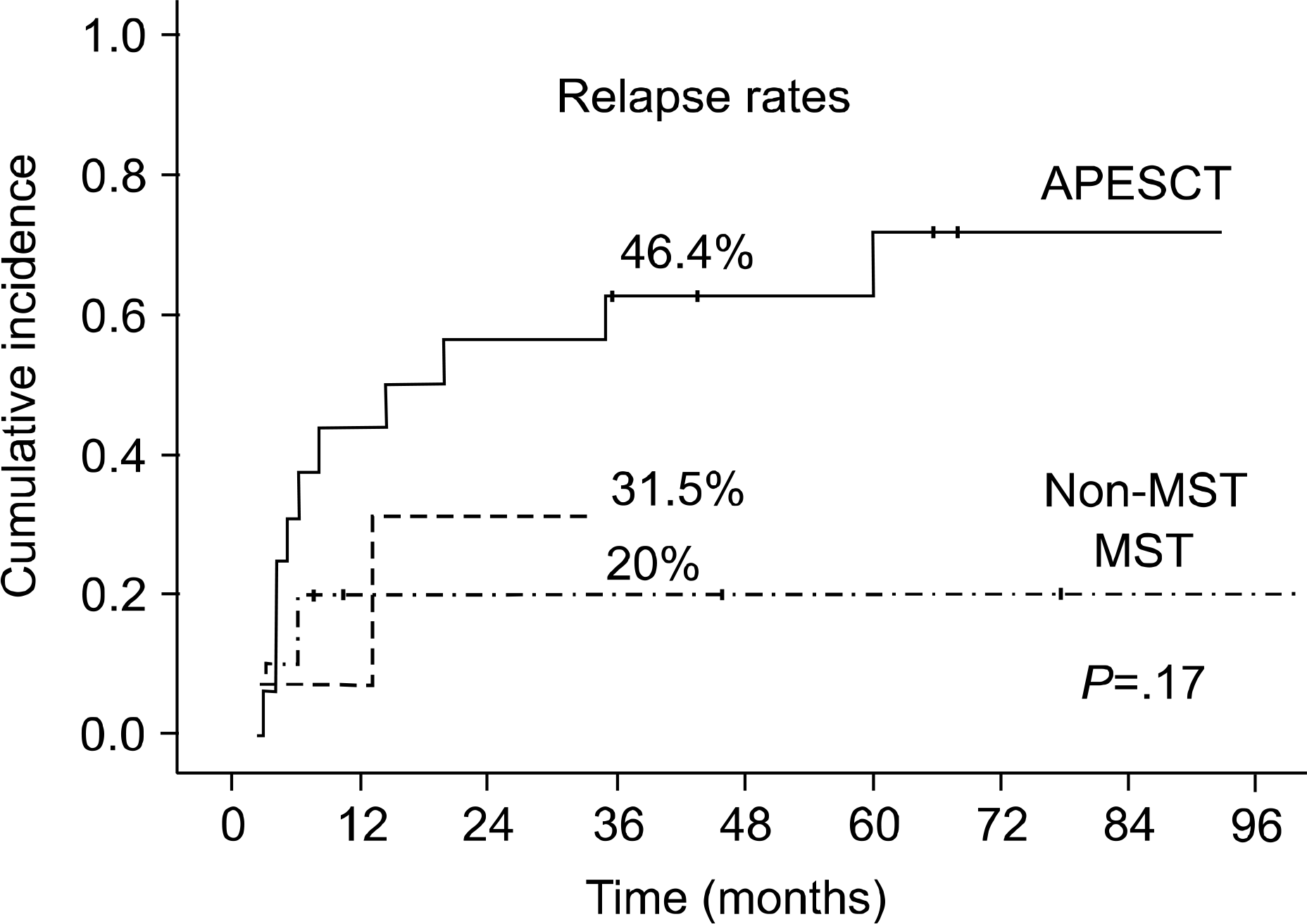Abstract
Background
Postremission therapy is critical for achieving longterm survival in the patients with acute myelogenous leukemia (AML). Allogeneic bone marrow transplantation during the first complete remission (CR) with using a HLA-identical sibling donor may offer the best chance for longterm leukemia-free survival. The patients without matched siblings have several treatment options. The aim of this study was to compare the clinical outcomes after matched sibling transplantation (MST), unrelated stem cell transplantation (non-MST), or autologous peripheral blood stem cell transplantation (APBSCT) as a postremission therapy for children with AML.
Methods
Thirty four hematopoietic stem cell transplantations (SCT) in 32 children with AML were performed between June, 1996 and December, 2004. Two patients who failed at prior APBSCT underwent a 2nd unrelated transplantations. The disease status at the time of transplantation, the conditioning regimen, prophylaxis for graft-versus-host disease (GVHD), the incidence of GVHD, complications, the cause of death, the overall survival and the event-free survival were retrospectively compared in relation to the stem cell sources.
Results
There were 19 males and 13 females with a median age of 8 yr 10 mo. The median follow-up was 17 mo. Twenty-eight cases were transplanted during CR1. Most (5/6) of patients other than the patients who were in CR1 were allocated in the non-MST group. APBSCT was done in 17 cases, and allo-transplants were done in 17 cases, which included MSTs in 10, matched-unrelated BM transplants in 5, haploidentical CD34+selected peripheral blood transplant in 1, and 1-antigen mismatch unrelated cord blood transplantation in 1. Acute GvHD ≥ than Grade 2 was found in 20% of the MST cases vs. 85.7% in the non-MST cases (P<.01). The two-year cumulative relapse risks were 46.4% in the APBSCT cases, 20% in the MST cases and 31.5% in the non-MST cases. The Kaplan-Meier 2-year EFS in all cases was 55.7%: 46.3% in the APBMT cases, 80.0% in the MST cases and 68.6% in the non-MST cases, despite the higher proportion of high risk patients in the non-MST group.
Conclusion
This study indicated that MST was the best option for pediatric AML. For patients without matched siblings, the patients with unrelated transplants fared better, had better survival and a lower relapse rate than the APBSCT patients. However, a further prospective, randomized study that incorporates a larger number of patients and a cord blood transplant arm is necessary to definitely determine the best option for pediatric
Go to : 
REFERENCES
1). Vormor J, Boos J, Stahnke K, Jurgens H, Ritter J, Creutzig U. Therapy of childhood acute myelogenous leukemia. Ann Hematol. 1996; 73:11–24.
2). Ebb DH, Weinstein HJ. Diagnosis and treatment of childhood acute myelogenous leukemia. Pediatr Clin North Am. 1997; 44:847–62.

3). Golub TR, Weinstein HJ, Grier HE. Acute myelogenous leukemia. Pizzo A, Poplack DG, editors. principles and practices of pediatric oncology. 3rd ed.Philadelphia: Lippincott-Raven;1997. p. 463.
4). Creutzig U, Ritter J, Zimmermann M, Schellong G. Does cranial irradiation reduce the risk for bone marrow relapse in acute myelogenous leukemia? Unexpected results of the childhood. AML Acute Myelogenous Leukemia study BFM-87. J Clin Oncol. 1993; 11:279–86.
5). Behar C, Suciu S, Benoit Y, et al. Mitoxantrone-containing regimen for treatment of childhood acute leukemia (AML) and analysis of prognostic factors: results of the EORTIC Children Leukemia Cooperative Study 58872. Med Pediatr Oncol. 1996; 26:173–9.
6). Stevens RF, Hann IM, Wheatley K, Gray RG. Marked improvement in outcome with chemotherapy alone in pediatric acute myeloid leukemia: result of the United Kingdom Medical Research Council's 10th AML trial. MRC Childhood Leukemia Working Party. Br J Haematol. 1998; 101:130–40.
7). Michel G, Leverger G, Leblanc T, et al. Allogeneic bone marrow transplantation vs aggressive postremission chemotherapy for children with acute myeloid leukemia in first complete remission. A prospective study from the French Society of Pediatric Hematology and Immunology (SHIP). Bone Marrow Transplant. 1996; 17:191–6.
8). Woods WG, Neudorf S, Gold S, et al. A comparison of allogeneic bone marrow transplantation, autologous bone marrow transplantation and aggressive chemotherapy in children with acute myeloid leukemia in remission. Blood. 2001; 97:56–62.
9). Ravindranath Y, Yeager AM, Chang MN, et al. Autologous bone marrow transplantation versus intensive consolidation chemotherapy for acute myeloid leukemia in childhood. Pediatric Oncology Group. N Engl J Med. 1996; 334:1428–34.
10). Tsai T, Goodman S, Saez R, et al. Allogeneic bone marrow transplantation in patients who relapse after autologous transplantation. Bone Marrow Transplant. 1997; 20:859–63.

11). Kim DW, Han CH, Kim HK, et al. Induction chemotherapy with BH-AC plus idarubicin in acute myelogenous leukemia. Korean J BRM. 1994; 4:203–8.
12). Park HS, Kim DW, Kim CC, et al. Induction chemotherapy with idarubicin plus N4-behenoyl-1-beta-D-arabinofuranosylcytosine in acute myelogenous leukemia: a newly designed induction regimen - a prospective, cooperative multicenter study. Semin Hematol. 1996; 33:24–9.
13). Park HJ, Yoon WS, Kim CJ, Oh HA, Kook H, Hwang TJ. Therapeutic results of two regimens for childhood acute myelogenous leukemia. Korean J Pediatr Hematol-Oncol. 1999; 6:68–77.
14). Yoon WS, Kook H, Park AN, Ryang DW, Hwang TJ. Peripheral blood stem cell collection and engraftment kinetics in pediatric patients. Korean J Pediatr Hematol-Oncol. 1999; 6:330–8.
15). Deeg HJ. Graft failure. Burt PK, Deeg HJ, Lothian ST, Santos GW, editors. On call in: bone marrow transplantation. New York: Chapman & Hill;2006. p. 306–16.
16). Glucksberg H, Storb R, Fefer A, et al. Clinical manifestations of graft-versus-host disease in human recipients of marrow from HL-A-matched sibling donors. Transplantation. 1974; 18:295–304.

17). Shulman HM, Sullivan KM, Weiden PL, et al. Chronic graft-versus-host syndrome in man. A longterm clinicopathologic study of 20 Seattle patients. Am J Med. 1980; 69:204–17.
18). Creutzig U, Zimmermann M, Ritter J, et al. Definition of a standard-risk group in children with AML. Br J Haematol. 1999; 104:630–9.

19). Creutzig U, Ritter J, Zimmermann M, et al. Improved treatment results in high risk pediatric acute myeloid leukemia patients after intensification with high-dose cytarabine and mitoxantrone: results of study Acute Myeloid Leukemia-Berlin-Frankfurt-Munster 93. J Clin Oncol. 2001; 19:2705–13.
20). Burnett AK, Goldstone AH, Stevens RM, et al. Randomised comparison of addition of autologous bone-marrow transplantation to intensive chemotherapy for acute myeloid leukaemia in first remission: results of MRC AML 10 trial. UK Medical Research Council Adult and Children's leukaemia Working Parties. Lancet. 1998; 351:700–8.
21). Tiedemann K, Waters KD, Tauro GP, Tucker D, Ekert H. Results of intensive therapy in childhood acute myeloid leukemia, incorporating high-dose melphalan and autologous bone marrow transplantation in first complete remission. Blood. 1993; 82:3730–8.

22). Ortega JJ, Olive T, Diaz de Heredia C, Coll MT, Bastida P, Massuet L. Allogeneic and autologous bone marrow transplantation in AML in first remission. The Spanish experience. Bone Marrow Transplant. 1996; 18(Suppl 2):53–8.
23). Bonetti F, Zecca M, Pession A, et al. Total-body irradiation and melphalan is a safe and effective conditioning regimen for autologous bone marrow transplantation in children with acute myeloid leukemia in first remission. The Italian Association for Pediatric Hematology and Oncology-Bone marrow Transplantation Group. J Clin Oncol. 1999; 17:3729–35.
24). Amadori S, Testi AM, Arico M, et al. Prospective comparative study of bone marrow transplantation and postremission chemotherapy for childhood acute myelogenous leukemia. The Associazione Italiana Ematologia ed Oncologia Pediatrica Cooperative Group. J Clin Oncol. 1993; 11:1046–54.

25). Ortega JJ, Diaz de Heredia C, Olive T, et al. Allogeneic and autologous bone marrow transplantation after consolidation therapy in high-risk acute myeloid leukemia in children. Towards a risk-oriented therapy. Haematologia. 2003; 88:290–9.
26). Sierra J, Storer B, Hansen JA, et al. Unrelated donor marrow transplantation for acute myeloid leukemia: an update of the Seattle experience. Bone Marrow Transplant. 2000; 26:397–404.

27). Godder K, Eapen M, Laver JH, et al. Autologous hematopoietic stem-cell transplantation for children with acute myeloid leukemia in first or second complete remission: a prognostic factor analysis. J Clin Oncol. 2004; 22:3798–804.

28). Nemecek ER, Gooley TA, Woolfrey AE, Carpenter PA, Matthews DC, Sanders JE. Outcome of allogeneic bone marrow transplantation for children with advanced acute myeloid leukemia. Bone Marrow Transplant. 2004; 34:799–806.

29). Neudorf S, Sanders J, Kobrinsky N, et al. Allogeneic bone marrow transplantation for children with acute myelocytic leukemia in first remission demonstrates a role for graft versus leukemia in the maintenance of disease-free survival. Blood. 2004; 103:3655–61.

30). Hale GA, Tong X, Benaim E, et al. Allogeneic bone marrow transplantation in children failing prior autologous bone marrow transplantation. Bone Marrow Transplant. 2001; 27:155–62.

31). Engelfriet CP, Reesink HW, Wagner JE, et al. International forum. Use of umbilical cord blood progenitor cells as an alternative for bone marrow transplantation. Vox Sang. 2002; 83:172–87.
32). Grewal SS, Barker JN, Davies SM, Wagner JE. Unrelated donor hematopoietic cell transplantation: marrow or umbilical cord blood? Blood. 2003; 101:4233–44.

33). Rocha V, Cornish J, Sievers EL, et al. Comparison of outcomes of unrelated bone marrow and umbilical cord blood transplants in children with acute leukemia. Blood. 2001; 97:2962–71.

34). Lemons RS, Keller S, Gietzen D, et al. Acute promyelocytic leukemia. J Pediatr Hematol Oncol. 1995; 17:198–210.

35). Fang J, Chen SJ, Tong JH, Wang ZG, Chen GQ, Chen Z. Treatment of acute promyelocytic leukemia with ATRA and As2O3: a model of molecular target-based cancer therapy. Cancer Biol Ther. 2002; 1:614–20.
Go to : 
 | Fig. 1.Kaplan-Meier analysis of (A) Overall survival and (B) Event free survival by stem cell source. |
Table 1.
Summary of patient's characteristics and stem cell transplantation
Table 2.
FAB classification
| APBSCT | Allo-SCT | Total | % | |
|---|---|---|---|---|
| M0 | 1 | 1 | 2.9 | |
| M1 | 0 | 0 | 0.0 | |
| M2 | 12 | 3 | 15 | 44.0 |
| M3 | 2 | 1 | 3 | 9.1 |
| M4 | 1 | 8 | 9 | 26.4 |
| M5 | 2 | 2 | 5.6 | |
| M6 | 1 | 1 | 2.9 | |
| M7 | 2 | 1 | 3 | 9.1 |
| Total | 17 | 17 | 34 | 100.0 |
Table 3.
Disease status at transplant by stem cell source
| APBSCT | MST | Non-MST | Total | |
|---|---|---|---|---|
| CR1 | 16 | 10 | 2 | 28 |
| CR2 | 1 | 0 | 2 | 3 |
| CR3 | 0 | 0 | 1 | 1 |
| Partial remission | 0 | 0 | 2 | 2 |
| % of high risk∗ | 5.8 | 0 | 71.4 | 17.5 |
Table 4.
Patient characteristics by stem cell sources
Table 5.
Complication after stem cell transplantation by stem cell source
| Auto (n=17) | MST (n=10) | Non-MST (n=7) | P value | |
|---|---|---|---|---|
| CMV | .10 | |||
| CMV culture | 1 | 0 | 2 | |
| CMV antigenemia | 0 | 0 | 2 | |
| CMV disease | 1 | 0 | 2 | |
| Bacterial infection | 0 | 0 | 3 | .40 |
| Fungal infection | 6 | 0 | 0 | .11 |
| Interstitial pneumonitis | 0 | 1 | 1 | .48 |
| VOD | 0 | 0 | 0 | |
| Hemorrhagic cystitis (No) | 2 | 2 | 1 | .90 |
| GI toxicity (stomatitis, N & V, diarrhea) | 4 | 1 | 2 | .57 |
| Life threatening bleeding | 0 | 0 | 1∗ | .60 |
| Acute GVHD (%) | 2 (20) | 7 (100) | <.01 | |
| Onset days (median/range) | 16 (2~30) | 16 (1~27) | .29 | |
| ≥Grade II | 2 (20.0) | 6 (85.7)∗ | ||
| Chronic GVHD | 1 (10%) | 3 (42%) | <.01 | |
| Onset days (median/range) | NK | 197.7 (132~277) | ||
| Limited/Extensive | 1/0 | 1/2 | ||




 PDF
PDF ePub
ePub Citation
Citation Print
Print



 XML Download
XML Download